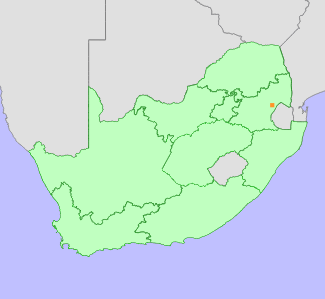|
Scientific Name | Protea roupelliae Meisn. subsp. hamiltonii Beard ex Rourke |
Higher Classification | Dicotyledons |
Family | PROTEACEAE |
Common Names | Hamilton's Silver Sugarbush (e) |
National Status |
Status and Criteria | Critically Endangered A2a |
Assessment Date | 2020/07/14 |
Assessor(s) | D. Raimondo, M. Lötter, R. Green & E.T.F. Witkowski |
Justification | Protea roupelliae subsp. hamiltonii is endemic to a very small area in Barberton. One subpopulation remains with an extent of occurrence (EOO) and area of occupancy (AOO) of 4 km². A population reduction of 84% took place between 1982 and 2000. There have been extensive management interventions and the population has been augmented with cultivated seedlings and introduced seed. Currently the population numbers 1053 mature individuals, however, it is not possible to tell which of these individuals have been the result of natural recruitment and which from managed reintroductions. No more direct introductions will take place and should the population remain stable or increase following two fire cycles the status of this species will be down listed. Currently it remains Critically Endangered and qualifies under criterion A2. |
Distribution |
Endemism | South African endemic |
Provincial distribution | Mpumalanga |
Range | This subspecies is endemic to a small area near Barberton in the Mpumalanga Province, South Africa. |
Habitat and Ecology |
Major system | Terrestrial |
Major habitats | Barberton Montane Grassland |
Description | It is found on bare, leached clay soils over quartzite in montane grassland, 1300 m. Mature individuals are suspected to be killed by fires, and only seeds survive. Wind-dispersed seeds are stored in fire-resistant inflorescences, and released after fires. It is pollinated by birds. |
Threats |
| About 80% of this taxon's habitat is irreversibly modified. It remains extant at only one location where it is threatened by competition from invasive alien species (pines, bugweed and bramble), too infrequent fires in grasslands and overgrazing by the common duiker, Sylvicarpa grimmia. |
Population |
Of the three known subpopulations, two became extinct as a direct consequence of afforestation at the Jambila Plantation and Nelshoogte State Forest. The only remaining subpopulation occurs at the Dr Hamilton Nature Reserve where in 1982 there were 1090 plants. This population declined to only 172 plants in the year 2000. At the time the reserve was being mismanaged with fires being excluded in order to protect surrounding plantations. In the early 2000s the plants had ceased growing and were not flowering or coning due to heavy grazing. There has been active management and re-introductory actions taken to save this taxon. Fencing off the population to prevent grazing resulted in flowering in 2005 for the first time in years. In 2008, 293 large ex situ cultivated seedlings were introduced, 272 of these survived in 2009. A second batch of seedlings (number unrecorded) was planted in October 2009. Furthermore, extensive seed augmentation took place and monitoring has recorded good establishment of planted seed. A rapid survey conducted in August 2020 noted that there are 1053 individuals. This indicates that recovery efforts are thus far working. It is however impossible to tell which individuals are from the original population and which were introduced. Furthermore the population has not been burnt for the past 12-15 years in order to allow the introduced seedlings a chance to cone and set seed. The population is currently showing indications of having the potential to recover well with 93% of the population having conned in the past few years. Indication of success of these recovery interventions will only be possible once the population has remained stable or increased naturally following two fire cycles. With the first fire planned for 2021 and natural grasslands fires occurring in 3-4 year cycles, we will only be able to tell if the population has recovered by the year 2030.
|
Population trend | Stable |
Conservation |
| The only remaining subpopulation occurs at a small nature reserve specifically established to protect this taxon: the Dr Hamilton Nature Reserve. |
Assessment History |
Taxon assessed |
Status and Criteria |
Citation/Red List version | | Protea roupelliae Meisn. subsp. hamiltonii Beard ex Rourke | CR A2ac; B1ab(i,ii,iii,iv,v)+2ab(i,ii,iii,iv,v); C2a(ii) | Raimondo et al. (2009) | | Protea roupelliae Meisn. subsp. hamiltonii Beard ex Rourke | Endangered | Hilton-Taylor (1996) | | Protea roupelliae Meisn. subsp. hamiltonii Beard ex Rourke | Rare | Hall et al. (1980) | |
Bibliography |
Hall, A.V., De Winter, M., De Winter, B. and Van Oosterhout, S.A.M. 1980. Threatened plants of southern Africa. South African National Scienctific Programmes Report 45. CSIR, Pretoria.
Hilton-Taylor, C. 1996. Red data list of southern African plants. Strelitzia 4. South African National Botanical Institute, Pretoria.
Raimondo, D., von Staden, L., Foden, W., Victor, J.E., Helme, N.A., Turner, R.C., Kamundi, D.A. and Manyama, P.A. 2009. Red List of South African Plants. Strelitzia 25. South African National Biodiversity Institute, Pretoria.
Schmidt, E., Lotter, M. and McCleland, W. 2002. Trees and shrubs of Mpumalanga and Kruger National Park. Jacana, Johannesburg.
|
Citation |
| Raimondo, D., Lötter, M., Green, R. & Witkowski, E.T.F. 2020. Protea roupelliae Meisn. subsp. hamiltonii Beard ex Rourke. National Assessment: Red List of South African Plants version . Accessed on 2025/09/02 |
 Comment on this assessment
Comment on this assessment

